Biology and Genetics of Hair
September 2010
in “Annual Review of Genomics and Human Genetics”
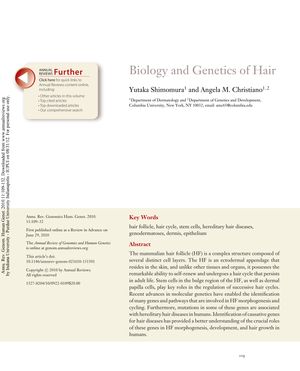
TLDR The document concludes that understanding the genes and pathways involved in hair growth is crucial for developing treatments for hair diseases.
The document from 2010 provides a comprehensive review of the biology and genetics of hair, particularly focusing on the mammalian hair follicle (HF) and its self-renewal capabilities through the hair cycle. It discusses the critical roles of stem cells in the bulge region of the HF and dermal papilla cells in regulating hair cycles. The paper identifies key genes and pathways involved in HF morphogenesis and cycling, including the Wnt signaling pathway and mutations in WNT10A and APCDD1 genes associated with hereditary hair diseases. It also explores the role of cadherin switching during HF induction and the impact of mutations in the P-cadherin (CDH3) gene on syndromic hair diseases. The document further examines the Eda-A1/Edar/Edaradd signaling pathway and its significance in HF morphogenesis, with mutations leading to conditions like hypohidrotic ectodermal dysplasia (HED). It describes the hair cycle, hair follicle stem cells, and hereditary hair diseases such as atrichia with papular lesions (APL) and Marie Unna hypotrichosis (MUH), both associated with mutations in the hairless (HR) gene. Additionally, the LIPH/LPA/LPAR6 signaling pathway's role in hair growth is highlighted, with mutations in these genes linked to hair disorders like autosomal recessive woolly hair (ARWH) and/or hypotrichosis. The importance of hair keratins and desmosomal components in hair structure and disorders, such as monilethrix and localized autosomal recessive hypotrichosis (LAH), is also discussed. Lastly, the document touches on polygenic hair diseases like androgenetic alopecia (AGA) and alopecia areata (AA), noting identified susceptibility loci and genes, and emphasizes the need for further research to understand human-specific HF morphogenesis and hair growth for potential new treatments for hair diseases.
View this study on annualreviews.org →
Cited in this study

research APCDD1 is a novel Wnt inhibitor mutated in hereditary hypotrichosis simplex
A gene called APCDD1, which controls hair growth, is found to be faulty in a type of hair loss called hereditary hypotrichosis simplex.

research Mutations in the Keratin 85 (KRT85/hHb5) Gene Underlie Pure Hair and Nail Ectodermal Dysplasia
Mutations in the KRT85 gene cause hair and nail problems.
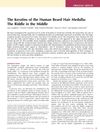
research The Keratins of the Human Beard Hair Medulla: The Riddle in the Middle
Human beard hair medulla contains a unique and complex mix of keratins not found in other human tissues.
research Desmoglein 4 is regulated by transcription factors implicated in hair shaft differentiation

research From Telogen to Exogen: Mechanisms Underlying Formation and Subsequent Loss of the Hair Club Fiber
Hair shedding is an active process that could be targeted to treat hair loss.
research A novel mutation in Hr causes abnormal hair follicle morphogenesis in hairpoor mouse, an animal model for Marie Unna Hereditary Hypotrichosis
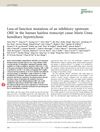
research Loss-of-function mutations of an inhibitory upstream ORF in the human hairless transcript cause Marie Unna hereditary hypotrichosis
Certain mutations in a hair growth-related gene cause a type of genetic hair loss.
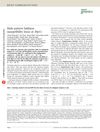
research Male-pattern baldness susceptibility locus at 20p11
Researchers found a new gene area linked to male-pattern baldness, which, along with another gene, significantly increases the risk of hair loss in men.
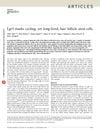
research Lgr5 marks cycling, yet long-lived, hair follicle stem cells
Lgr5 is a marker for active, long-lasting stem cells in mouse hair follicles.
research A position effect on TRPS1 is associated with Ambras syndrome in humans and the Koala phenotype in mice

research Genome-wide Scan and Fine-Mapping Linkage Study of Androgenetic Alopecia Reveals a Locus on Chromosome 3q26
Hair loss gene found on chromosome 3q26.
research Disruption of P2RY5, an orphan G protein–coupled receptor, underlies autosomal recessive woolly hair
research Hair follicle-specific keratins and their diseases
research The Wnt inhibitor, Dickkopf 4, is induced by canonical Wnt signaling during ectodermal appendage morphogenesis
The study found that the protein Dkk4 helps regulate hair growth by controlling Wnt signaling in mice.
research Human Hair Growth Deficiency Is Linked to a Genetic Defect in the Phospholipase Gene LIPH
research Mutations in the Desmoglein 4 Gene Are Associated with Monilethrix-like Congenital Hypotrichosis
research Characterization and isolation of stem cell-enriched human hair follicle bulge cells
Researchers successfully isolated and identified key markers of stem cell-enriched human hair follicle bulge cells.

research Hairless triggers reactivation of hair growth by promoting Wnt signaling
The HR protein helps hair grow by blocking a hair growth inhibitor, aiding in hair follicle regeneration.

research Genetic Variation in the Human Androgen Receptor Gene Is the Major Determinant of Common Early-Onset Androgenetic Alopecia
Genetic variation in the androgen receptor gene mainly causes early-onset hair loss, with maternal inheritance playing a key role.
research Molecular principles of hair follicle induction and morphogenesis
Hair follicle development is controlled by interactions between skin tissues and specific molecular signals.
research The lanceolate hair rat phenotype results from a missense mutation in a calcium coordinating site of the desmoglein 4 gene
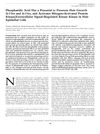
research Phosphatidic Acid Has a Potential to Promote Hair Growth In Vitro and In Vivo, and Activates Mitogen-Activated Protein Kinase/Extracellular Signal-Regulated Kinase Kinase in Hair Epithelial Cells
Phosphatidic acid may help hair grow by affecting cell growth pathways.
research Molecular Mechanisms Regulating Hair Follicle Development
Understanding hair follicle development can help treat hair loss, skin regeneration, and certain skin cancers.
research Morphogenesis and Renewal of Hair Follicles from Adult Multipotent Stem Cells
Adult mouse skin contains stem cells that can create new hair, skin, and oil glands.
research The Catalog of Human Hair Keratins
Human hair is made up of different keratins, some strong and some weak, with specific types appearing at various stages of hair growth.
Related
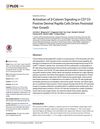
research Activation of β-Catenin Signaling in CD133-Positive Dermal Papilla Cells Drives Postnatal Hair Growth
Activating β-catenin in certain skin cells speeds up hair growth in mice.

research Dermal sheath cells contribute to postnatal hair follicle growth and cycling
Skin sheath cells help in hair growth and renewal after birth.

research Blockade of S100A3 activity inhibits murine hair growth
Stopping S100A3 activity slows down hair growth in mice.
research An estrogen receptor pathway regulates the telogen-anagen hair follicle transition and influences epidermal cell proliferation.
Estrogen affects hair growth and skin cell multiplication.